Monuments in St Dunstan's Stepney
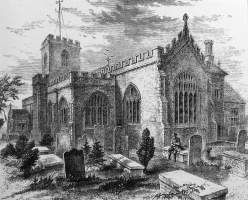 St Dunstan's Stepney, late 19th C.
St Dunstan's Stepney, late 19th C.
St Dunstan’s Stepney is one of the most important medieval churches in London, and contains significant monuments of
interest to these pages. Most of the church dates from the late 15th or early 16th Century, with the chancel being earlier
(apparently mid-13th Century), and something of a restoration and a reworking of the exterior in the 19th Century,
which saw the additions of the porches and the cladding of the exterior in Kentish ragstone.
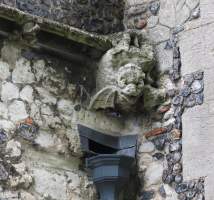 Fishy little gargoyle.
Fishy little gargoyle.
What we see from the outside has a medieval feel to it: a 150 ft long, low church, really rather large for the times,
with two aisles, a solid tower, all castellated on top, a range of broad Gothic windows, taller and narrower on the tower,
and good details, including a few sculpted gargoyles, much weathered, but still rather engagingly horrible little beasts.
The main entrance under the tower, reworked in presumably Victorian times, has crisp roundels showing a stylised ship and a
grotesque figure, cloven footed and with pointed tail, clutching some instrument.
The church is surrounded by greenery, with various large table tombs dotted around. The one nearest to the south porch has
distinctive cherub heads at each corner. The softness of the stone and the covering of moss make it not possible to readily
read the inscription today, but this is the tomb of Captain Richard Mathew, 1663, and his daughter Elizabeth,
wife of John Marsh, d.1695.
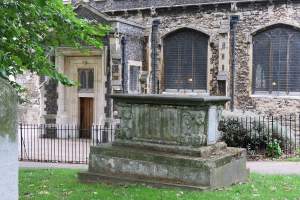 Tomb of Captain Richard Mathew, 1663.
Tomb of Captain Richard Mathew, 1663.
Inside, the breadth and lowness are accentuated by the openness of the aisles and the dark wooden ceiling to the nave,
not much higher than the aisles. The monuments we have come to see are between each window all the way along, on the lower
walls, and in the chancel near the altar – the oldest part of the church.
The earliest carving, behind the altar and older than the oldest part of the church, is an Anglo Saxon crucifixion on a
flat plaque, with two female saints below (presumably Mary and St John), and rosettes or whorls containing leaves all round.
Saxon work is incredibly rare in London, and though crudely done, and having lost much to time and the weather (it hung outside previously),
the piece exudes history and presence. It has been dated variously to between the 10th and the 12th century.
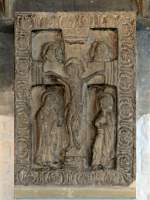
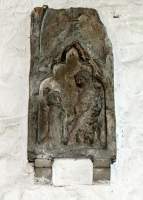 Saxon Crucifixion, and 14th C Annunciation (presumed).
Saxon Crucifixion, and 14th C Annunciation (presumed).
To the left, above the little door in the sanctuary to the Vestry, is a sculpted fragment showing
a female figure in a cowl, with a kneeling figure before her, supposedly and plausibly an Annunciation,
under a cinquefoil Gothic arch. 14th Century, apparently, and believed to come from a reredos.
Just outside the chancel, to the left, against the wall of the North aisle, is a heavy coffin with a cross,
perhaps 13th Century, which would make it of similar date to the earliest part of the church, and to the right, one corbel to the arch
has a recognisable monster, rather dragonish, rather good, of similar date. It is carved as a grotesque, with the head,
front part of the body and outstretched foreleg naturalistic, a leafy wing, and the tail splitting into two leafy decorations;
the breath or fire from the dragon’s mouth becomes further leafy designs. A corbel on the north side is less interesting,
being a crudely cut face of some animal, which it is hard to take any view on.
Moving to the conventional monuments, we note them in roughly date order:
From the 16th Century:
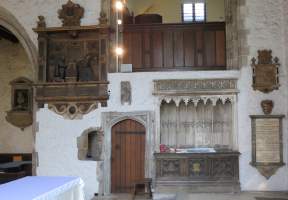 Group of monuments, including the great altar tomb to Henry Collet (d.1510).
Group of monuments, including the great altar tomb to Henry Collet (d.1510).
- Sir Henry Collet, Knight, d.1510, twice mayor of London (1486, 1495). A great altar tomb with three square
panels on the side, each divided with a quatrefoil and with smaller quatrefoils within the shapes thus formed, and a central
shield, blank bar the middle one which has the short inscription set in brass. A recess above, with lovely architectural
mouldings, with fan vaulting and hanging carved pendants or corbels; more quatrefoils etc above. We might mention that his son,
John Colet, a vicar here, apparently founded St Paul’s School.
- William Dawtrey, d.1589, a panel with a Latin inscription. It has a red-brown marble or alabaster surround;
pilasters, a relatively large shield above, and two accompanying circlets, and a shaped apron below.
I have not seen enough work from this period of this style to notice what is characteristic of that time.
The monument can be seen to the upper right of the Collet tomb in the picture above.
Brasses such as that to the wife of John Brewster, 1596, are outside the scope of these pages.
And we consider the monument to Sir Thomas Spert, d.1541, under the 18th Century, when it was erected.
From the 17th Century:
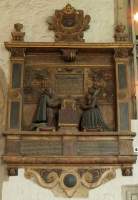
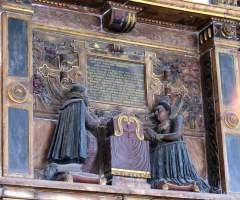 17th Century kneelers - Robert Clarke, monument erected by his wife Margaretta.
17th Century kneelers - Robert Clarke, monument erected by his wife Margaretta.
- Jane Neville, Lady Detheck, d.1606, with a Latin inscription. A rather grand tablet.
Arched black panel with darkened red-brown marble surround, side pillars Doric, coat of arms in circlet above,
carefully carved apron below, with room for a small inscription, now darkened. Clicking on the interior view of the church
lower down this page, her monument is the large, prominent one on the near right.
- Rebecca Berry, d.1606, wife of Thomas Elton, oval shield in marble with scrolls, cherub heads,
shield of arms, and topped by a lamp. All very worn, and beginning to look like Linear A. The inscription,
as transcribed in various books, is a rather nice poem, beginning ‘Come, Ladies, you that would appear/
Like angels fair, come dress you here./ Come dress you at this marble stone…’
- Roberte Clarke, d.1610, and infant daughter, with inscription noting he was son of Roger Clarke, Alderman
of the City of London, and that his wife, Margaretta, daughter of John Langton, sometime Governor of the English Company in
Sprucia under the King of Polonia, had raised the monument. This is our earliest memorial in the church with figures.
Clarke and his widow are depicted conventionally as two kneelers with the usual desk between them (more on such monuements on this page).
He is wearing a cloak and rather bulgy clothes, she a heavy skirt and a tall ruff or neckpiece. Between them and above
the desk is a further inscription in Latin; the background is carved with mixed decorative devices, including fruit, ribbons,
scrolls, tassels etc. Thick pilasters to the sides with Tudor roses at the tops, and above the shelf, little pots on plinths,
and centrally, coat of arms in an ornately carved surround. More decoration of stylised flowers and leaves form a pattern on
the apron. The whole in black and coloured marbles and alabaster, painted and gilded.
- Elizabeth Startute, d.1620. We see Captain Michael Merriall and wife Clare, daughter of Elizabeth Startute as
a pair of kneelers, man and wife, facing each other over a low desk as usual, he in ornate armour, she draped in black,
with above, the single figure of Elizabeth Startute herself, obscured in the general gloom, also kneeling,
facing to left, centrally placed. Thus there are two stages to this monument. Black Corinthian pillars to left and right of
the couple, and smaller ones in darkened brown marble to the mother. The lower pair supporting a wide shelf with hanging
bosses, serving as base to entablature and the upper figure. Brackets below with Tudor flowers. At the very top, coat of arms
in cartouche. The bottom testimonial states that the monument is to Elizabeth Startute, with the daughter and husband having
erected it.
- Three little plain plaques, darkened and worn. Ho[N?]Ly L…, d.1648; Richard E… d.1663 or 7; Elizabeth … M?.
Above right is a better preserved one to Abraham Rallings, Mariner, and Abraham his son, both d.1644.
- John Berry, d.1689, with a short Latin inscription, and a portrait bust, standing atop a semicircular
pediment above the inscription, with a niche behind, flanked by pilasters and topped off with a full pediment.
Fluted shell-like side borders to the inscription, and a small bracket below carved with a stylised grape vine leaf and grapes.
The bust shows a periwigged face, rather plump, with something of an air of grandeur and pride. I do not know the sculptor,
but belying its apparent simplicity, this is a work of considerable assuredness and skill.
Also from the 17th Century, we note the Stone brought from Carthage, and inscribed in 1663,
with a little ditty: ‘Of Carthage wall I was a Stone/Oh Mortals Read with pity./ Time Consumes all it Spareth none/
Man, Mountain, Town nor City./ Therefore Oh Mortals now bethink/ You, where unto us must,/ Since now such Stately Buildings/
Lie Buried in the dust. THOMAS HUGHES, 1663’
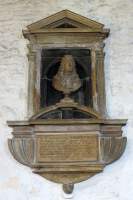
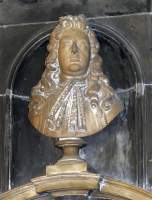
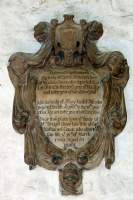
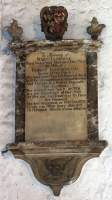
Late 17th C bust of John Berry; early 18th C cartouche to Nathaniel Owen and wives; Mary Leyborne monument with skull.
From the 18th Century:
The clutch of eight monuments from the 18th Century are almost all worthy, sculpturally speaking:
- Captain Nathaniel Owen, d.1708, of Mile End Green, and first wife Mary, d.1685,
and late wife Bridget, d.1709. A cartouche with complex border of drapery, scrolls, acanthus leaves,
a cherubic head left and right, and at the base a skull with bat wings. Above, his coat of arms. Accomplished carving.
- Sir Thomas Spert, d.1541, but the monument seemingly erected in 1725. He was ‘some tyme comptrowller
of the Navy to King Henry the 8th and both the first Founder and Master of the Worthie Society or Corporation called the
Trinity House’. The inscription goes on to opine that ‘Not that he needed Monuments of stone for his well gotten Fame’,
with which sentiment we must disagree. A lower inscription records that the monument was only erected in 1725.
A rich alabaster and marble piece, with the main inscription cut into black stone, arched, with a gilded surround with flowers
and little cherubic heads in dark reddish stone like jewels, two dark Corinthian pillars in front of lighter pilasters,
his coat of arms at the top with two obelisks (much associated with death at this time), and at the base, a carving of a
three-masted ship with flags flying. The monument was erected by the Company of Trinity House, and a final inscription
at the very bottom notes that it was ‘again repaired and beautified’ by them in 1806.
- Hugoni James Hugonis, (Hugo James) d.1728, with a Latin inscription. Veined marble panel with a rectangular
frame, a small cartouche above, depicting a red cross, and a knights helm above.
- Revd Thomas Dod, Rector, d.1727, and family, including wife who erected the monument, d.1773.
With a grey and white marble surround, and on top a shield in a cartouche, and beneath, an apron bearing a skull biting grimly
on a pair of wings. It can be discerned as the lower monument to the right of Collet's tomb, pictured above.
- Jacob Augustus Blondel, d.1734, with a long Latin inscription, flanking fluted pilasters,
shelves top and bottom. In place of a pediment are two seashells as lamps with flames coming out of the right hand one
(the left one is damaged), and a central shield in a small cartouche.
- Alexander Weller, d.1734, of Steward Street, Old Artillery Ground, Citizen and Silk thrower,
and one of his Majesties Justice’s of the Peace. Cartouche with splendid swirly drapery all around, and room for a shield,
now blank, above, with a knight’s helm and acanthus leaves above. The base as a hanging drape with a fringe, and a carved
pair of fronds tied with a ribbon.
- Mary Leyborne, d.1737, with an inscription reading rather oddly to modern eyes:
‘She was Pious, Cheerfull, Prudent, Liberal,/ In all the Accomplishments of Good Breeding/And Vertues of a Perfect Houswife/
Most Excellent:/ She wanted not Spirit, or Wit,/Or a Just Knowledge of Her Selfe/ Yet Her sole Ambition was to Please/
Her Husband./ She had no Interest, or Will but HIS./ Never was Man more Belov’d;/ Or Woman Deserv’d more Affection.’
With pilasters, shelves, a shield and two lamps as flaming shells flanking, and the apron beneath with a little winged skull
biting on a thighbone.
- Henry Leche, d.1742, Clerk, late Rector. Small monument with two fluted pilasters, a shield above with
knight’s helm with perhaps a dagger handle sticking out of the top, and a snake coiled round it; below, the large bracket
has two crossed fronds with a skull staring between them.
19th Century:

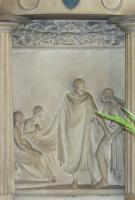 Benjamin Kenton memorial, by Sir Richard Westmacott RA.
Benjamin Kenton memorial, by Sir Richard Westmacott RA.
The turn of the century brings us immediately to a work by a notable sculptor, back in the chancel:
- Benjamin Kenton, d.1800, with inscription praising his philanthropy. A grand Classical monument in white marble,
with a sculpture in high relief of a version of the Good Samaritan - a bearded man holding the hand of an elder on the one
side, while to his other are two seated women, one with hands clasped in eloquent need. The strong work of the sculptor
Sir Richard Westmacott RA. All in classical garb, and with
lightly sketched drapes behind them, and underneath a quote from St Luke ‘And on the morrow when he departed he took out two
pence, and gave them to the Host, and said unto him, Take care of him.’ The composition is between and partly behind two
fluted pillars, holding up an entablature with three shields separated by snakes swallowing their tails. The main inscription
below is flanked by two staffs with snakes wound about them in the well-known symbol of medicine due to Asclepius.
Little wave forms underneath, and other minor decoration – given the different treatment, all this decoration is almost
certainly not by Westmacott, who would have confined himself to the central panel.
- Ann Moor, wife of Capt John Moor, d.1804, at Demerary, South America. Plain panel.
- Ann, Daughter of Capt Robert & Mrs Grace Elder, d.1811, bequeathed £5 a year to keep her family tomb in
substantial and decent repair. Plain plaque with a lower shelf. Beneath it, larger monumental plaque to Ann Elder, undated and with worn inscription, ‘gave by will the Interest of £315 … daughters of Master Mariners … have … the services and sacraments of the Church of England and be of deserving character, and that their respective ages be not under 20 years.
- John Charrington, d.1815, and wife Katherine, d.1815, panel with eared pediment above a thick shelf with wavy
decorations, and below the inscription, a decoration of fronds tied together with a ribbon. The sculptor of this work, rather
obscure, was Humphrey Thomas of London, and this may be his last known work.
- Sticking with the Charringtons, for the moment, a panel records that the West Window was restored by the Charrington
family in memory of this same John Charrington, d.1815, wife Katharine d.1815, and son Nicholas Charrington, d.1827, and his
wife Harriett, d.1863. And below it is a brass panel that the church was restored and the second vestry and porches erected by
voluntary contributions in 1871/2; the architects are noted as Newman & Billings FRIBA, and the builders F. and F.J. Wood.
- Out of chronological sequence, we note Lieut Harold Charrington, d.1882, of her Majesty’s ship Euryalus,
killed by the Bedouin Arabs while engaged on a confidential mission in the desert of Mount Sinai, Arabia, in connection with
the War in Egypt. Marble tablet in dark surround with simple open pediment and broad supporting bracket underneath.
Also John Charrington, d.1979, chairman of Charrington’s Brewery, plain panel with an incised anchor and
two sprigs of some plant. Nice to see a modern panel, though given the means of the family concerned, one might have hoped for
a bust or statue to go with it.
- Revd. George Harper, d.1815, Rector. Styled as a coffer tomb end, with legs and a carved top,
flanked by pilasters decorated with stylised flowering plants, and a drape at the top of the open space; above that,
a pediment with almost no border, enclosing a shield within a wreath resting on two palm fronds. The work of a fairly
prolific sculptor, Charles Regnart of London.
- Nicholas Dixon, d.1818, and wife Elizabeth Ann, d.1823. Plain panel with only the bottom
border remaining from some frame.
- Emma Rimington, d.1852, wife of Michael Rimington of Bombay and daughter of Edward Thornhill of Upper Clapton,
who died at Alexandria, Egypt on her passage to India. Plaque in a plain, dark frame.
- Joseph Somes, d. 1845, MP for Dartmouth, ‘the most extensive Ship Owner of this great Commercial Country’ etc,
the monument erected by his widow, Maria Somes. With a fine panel showing a pair of ships alongside the port below,
and a shield above, and some sort of entablature. The whole inexcusably three-quarters hidden behind the organ.
Understandably, the organ needed space, but the monument must have been movable to some other place in the church.
The sculptor of this work was apparently M.W. Johnson, a moderately prolific statuary.
- Joseph Cooper, d.1874, the inscription as a simple pale marble scroll, on a black backing, signed by Gaffin, 63 Regent Street, and typical of the work of this extremely prolific establishment.
In summary, an excellent church and well worth a visit.
A few minutes walk away, up the High Street and along Stepney Green, is an interesting pair of sculptured panels from the 1910s on a
small clock tower - see this page.
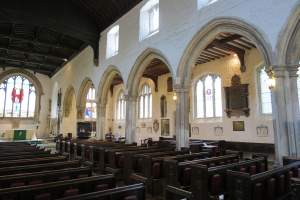
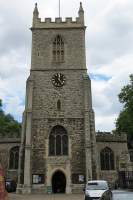 Interior view, and tower of St Dunstan's Stepney.
Interior view, and tower of St Dunstan's Stepney.
With thanks to the church authorities for kindly agreeing to include pictures of the interior and monuments; their website
is at this address.
Top of page
Monuments in some London Churches // Churches in the City of London // Introduction to church monuments
Angel statues // Cherub sculpture
London sculpture // Sculptors
Home
Visits to this page from 8 Aug 2012: 15,061
 St Dunstan's Stepney, late 19th C.
St Dunstan's Stepney, late 19th C.
 St Dunstan's Stepney, late 19th C.
St Dunstan's Stepney, late 19th C.
 Tomb of Captain Richard Mathew, 1663.
Tomb of Captain Richard Mathew, 1663.

 Saxon Crucifixion, and 14th C Annunciation (presumed).
Saxon Crucifixion, and 14th C Annunciation (presumed).
 Group of monuments, including the great altar tomb to Henry Collet (d.1510).
Group of monuments, including the great altar tomb to Henry Collet (d.1510).

 17th Century kneelers - Robert Clarke, monument erected by his wife Margaretta.
17th Century kneelers - Robert Clarke, monument erected by his wife Margaretta.





 Benjamin Kenton memorial, by Sir Richard Westmacott RA.
Benjamin Kenton memorial, by Sir Richard Westmacott RA.

 Interior view, and tower of St Dunstan's Stepney.
Interior view, and tower of St Dunstan's Stepney.